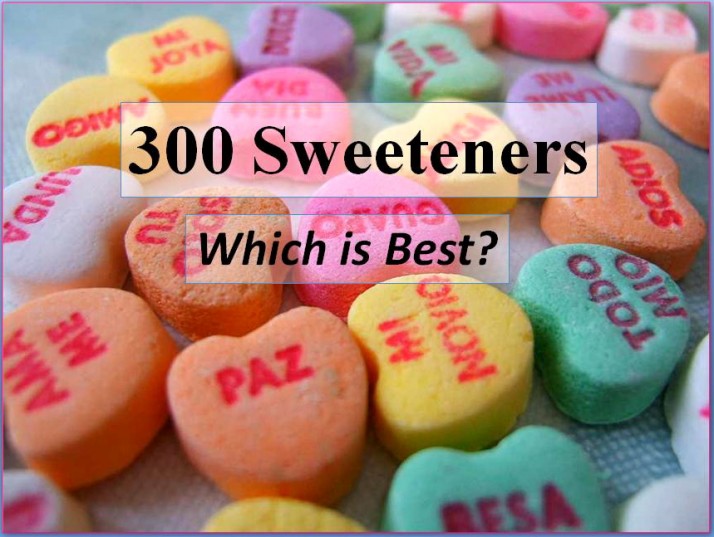With over 300 sweeteners in groceries and prepared foods, how can we choose wisely? Find the best sweeteners, and learn how to select them yourself. This is an exhaustive list of 325 sweeteners available today. I find it very interesting and you may too.
Download List of Sweeteners as pdf Download as Excel File
This is my best information to date, gleaned from prepared food labels and online research. It shows the categories for each sweetener and its ingredients when possible. The list is far from complete, as we invent new sweeteners every day to satisfy our increasing demand. This chart is intended to inform and to invite better understanding of sweeteners in our food supply. I invite your comments and corrections.
I use 12 classes of sweeteners. These classes are not mutually exclusive.
A. Best Sweeteners
There are only 3 sweeteners I consider BEST. That’s because they are zero or very low carb, they’re easy to find, they taste delicious, and are easy to use in recipes. Best of all, they are natural, non-GMO and Paleo. See my articles Best Natural Sweeteners or Paleo Sweeteners for more details.
Just Like Sugar Table Top
A zero calorie, zero glycemic, zero carb granulated sweetener made from natural chicory root dietary fiber, Use it cup for cup like sugar. You can find it in some Whole Foods Markets, or ask them to order it for you. Buy it online from JustLikeSugarInc.com, Vitacost.com, Netrition.com, or Amazon.com. Click for more information.
Organic Zero Erythritol
(Ah-REETH-ra-tall) looks and tastes like table sugar. Don’t be fooled by its name, Erythritol is a natural sweetener. You can buy Organic Zero Erythritol at whole foods markets, Wholesomesweeteners.com or Amazon.com. Click for more information.
Raw Yacón Syrup
This is a delicious caramel tasting syrup from a South American root. Look for raw Yacón, which is lower in carbs than cooked syrup. Find raw Yacon syrup at good whole food markets, food coops, NavitasNaturals.com or Amazon.com. Click for more information.
B. Zero Carb Sweeteners – This is a class of sweeteners that contain no carbs and no sugars of any kind. They do not cause a blood sugar spike or insulin response. That is great, but it doesn’t necessarily make them healthy. We need to look at the other qualities too. For example, Stevia leaf and aspartame are zero carb sweeteners.
C. Low Carb Sweeteners – These have relatively low carbs, or low sugars compared to table sugar.
D. Paleo Sweeteners – These are natural and could be gathered or made in the Paleolithic period. Examples are raw honey, chicory root, stevia raw leaf, maple sap – raw, and Brazzein berries from West Africa.
E. So-called “Natural” Sweeteners – These are sweeteners that many people consider “Natural”, and they may be somewhat less refined than table sugar. Examples are Turbinado sugar, rice syrup, honey and maple syrup. “Natural” is not an indication that they’re healthy – we need to first consider other factors like the carb level and production methods. See my article Natural Sweeteners – A Closer Look.
F. High Carb Sweeteners – Most of our common sweeteners are high in carbohydrates. Anything high in carbs will give you a blood sugar spike or insulin response, which destabilizes metabolism. There are many types of sugars: glucose, fructose, lactose, etc. All sugars are a type of carbs. Carbs are easy to find on nutrition labels.
G. High Fructose Sweeteners – Fructose is a specific type of sugar that is natural, occuring in plants. Example: Fruit juice, high fructose corn syrup, agave syrup, bananas. Recent research shows that fructose is linked to lipid fat deposits in the liver, arterial plaque, obesity and other diseases. So it’s a good idea to limit consumption of fructose. Most sweeteners contain several types of sugars, so this category is a simplification.
H. High Glycemic Sweeteners – These sweeteners are high in glucose, one of the sugars in table sugar. Glucose causes a glycemic rise in blood sugar, followed by a sudden drop. The constant see-saw in blood sugar destabilizes the metabolism and has been linked to accelerated aging, weak immune system, and other metabolic diseases. Most sweeteners contain several types of sugars – for example, table sugar is made up of both glucose and fructose. So this category is also a simplification.
I. Fermented Sweeteners – This is a class of crystalline fermented plant sweeteners, known as Polyol sweeteners, such as Erythritol and Xylitol. Fermented sweeteners have a similar structure to a glucose molecule, but the carbs are not digested in the same way. Fermented sweeteners are lower in carbs than table sugar. That’s a good sign.
J. High Intensity Sweeteners – These high potency sweeteners range from 3 times to 13,000 times sweeter than sugar. Most of them are artificial, however some are 100% natural. You won’t find many high intensity sweeteners listed on packaged food labels. Their miniscule weight is well below the legal minimum of 0.5 grams per serving, so there is no requirement to disclose them. A few high intensity sweeteners are made with nano technology – a growing industry that alters molecules on a microscopic atomic scale.
K. Industrial Sweeteners – These are sweeteners that are created by and/or intended for use in the food industry. There are a great many industrial sweeteners made for specific commercial purposes, and equally many unknowns about their production methods or ingredients. I’m including refined Stevioside and Rebaudioside in this category, as there is no clear information available about the chemicals used to extract and produce them.
L. Artificial Sweeteners – This is a class of sweeteners that are chemically created non-caloric sugar substitutes. They are used to replace sugar sweetness and sugar calories, and are usually high intensity. Examples are aspartame and sucralose. These are often called non-nutritive sweeteners, as opposed to “nutritive” sweeteners like glucose.
Download List of Sweeteners as pdf Download List of Sweeteners as Excel File
See also my articles Paleo Sweeteners, Best Natural Sweeteners, or “Natural” Sweeteners -A Closer Look










